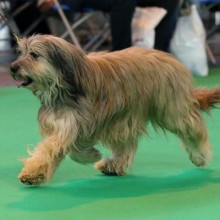Catalan Sheepdog
Lifestyle Needs
 The Catalan Sheepdog breed originates from the Andorra region of Spain and was used for herding and guarding flocks. The Catalan’s long, weather proof coat (double coated) requires very regular grooming. He is a natural guard dog, is courageous and therefore requires quite firm handling. His height is normally between 45 and 55 cm. He needs to live in a house with a garden and have plenty of opportunities for interactive play and off lead exercise. As all working breeds, the Catalan is intelligent and needs plenty of mental stimulation and training.
The Catalan Sheepdog breed originates from the Andorra region of Spain and was used for herding and guarding flocks. The Catalan’s long, weather proof coat (double coated) requires very regular grooming. He is a natural guard dog, is courageous and therefore requires quite firm handling. His height is normally between 45 and 55 cm. He needs to live in a house with a garden and have plenty of opportunities for interactive play and off lead exercise. As all working breeds, the Catalan is intelligent and needs plenty of mental stimulation and training.
Genetic Diversity
(Known as Coefficient of Inbreeding: 'COI'. It should be as low as possible.)
The UK Kennel Club breed average COI is 9.6% - See 'A Beginners Guide to COI'
Gene Pool Size
(Known as Effective Population Size: 'EPS')
TBC
EPS is a measure of how many individuals are contributing genetically to a breed population. It is a measure of the size of the gene pool in a breed. Lower than 100 is considered critical by conservationists and below 50 brings a breed close to extinction. For more information see the Kennel Club article.
Health and Welfare Problems due to Conformation
(Body shape and physical characteristics)
- The long, double, weatherproof coat can easily become matted and harbour dust and debris if not looked after daily.
BVA/KC Health Schemes: www.bva.co.uk/chs
- Hip Dysplasia: breed 5 year mean score 9.8 (parents should be lower)
- Eye Scheme: Progressive Retinal Atrophy (PRA); all dogs considered for breeding must be visually examined for inherited eye diseases
Estimated Breeding Values (EBVs) : No EBVs are currently available for this breed
www.thekennelclub.org.uk/about-ebvs
DNA Tests Available
DogWellNet and IPFD Harmonisation of Genetic Testing for Dogs (HGTD)
www.dogwellnet.com/breeds
None known
Availability of a DNA test does not mean that it is always necessary or even desirable for breeders to use this test.
Other Breed-Specific Health Screening Schemes
Patellar luxation test
Ask the breeder to show you the certificates for the above tests/screening for both parents. If any of the above tests have not been considered necessary by the breeder (and there may be good reasons), ask her to explain why.
Other Diseases Reported
(For which there are currently no genetic or screening tests for sire or dam)
- Patellar Luxation (PL)
- Glaucoma
- Epilepsy
Ask the breeder about the medical history of the parents, grandparents and great grandparents. Consider carefully whether to purchase a puppy if some of these or other diseases are in the family line.
Ask about the breeder’s policy in cases of serious genetic diseases occurring to your puppy in later life. Good breeders will request to be informed of such events in order to improve future breeding decisions.
You are strongly advised to buy from a breeder who uses (or is prepared to use) the AWF Puppy Contract and Puppy Information Pack (PIP): www.puppycontract.org.uk
The breeder should also be familiar with the CFSG/DBRG Code of Practice for Dog Breeding